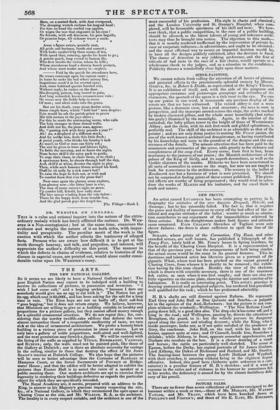, SCENE - PAINTING.
We cannot refrain froth calling the attention of all lovers of pictures and pictorial effects to the preeminently splendid scenery by Messrs. GRIEVE, &c. in Robert le Diable, as represented at the King's Theatre. It is an exhibition of itself, and, with the aids of the gorgeous and appropriate costumes and picturesque groupings and attitudes of the characters, the spectacle of the opera is a rich treat to the eye. To sum up our praise in one word, it transcends any previous display of the scenic art that we have witnessed. The ruined abbey is not a mere picture, like a diorarnic view, but a real structure; the nave is seen in perspective, and the transepts stretchacross the stage, the aisles marked by broken clustered pillars, and the whole most beautifully (but rather too gayly) illumined by the moonlight. Again, in the interior of the cathedral, the lofty pillars tower to the height of those of Westminster Abbey; and the choir, with its rich fret-work and gilded splendours, is perfectly real. The skill of the architect is as admirable as that of the painter ; and we are only doing justice in naming Mr. PUGIN junior, the son of the well-known architect and draughtsman, as having contributed by his knowledge and taste to the grandeur of the designs and the cor- rectness of the details. The minute attention that has been paid to the ornaments and accessaries of the scene, adds greatly to the richness and completeness of the coup Every scene, from first to last, bears testimony to the justness of our praise; the Moorish architecture of the palace of the King of Sicily, and its superb decorations, as well as the Gothic cloisters of the monks. Hitherto we have been accustomed to all sorts of anomalies in scenes on the stage, but now we are taught to look for correctness in the architecture. The scenery in the ballet of Kenilworth was but a foretaste of what is now presented. We should not be surprised at finding prints of these scenes published. The picto- rial effects are worthy of being perpetuated ; they would rival in splen- dour the works of MARTIN and his imitators, and far excel them in truth and nature.



























 Previous page
Previous page